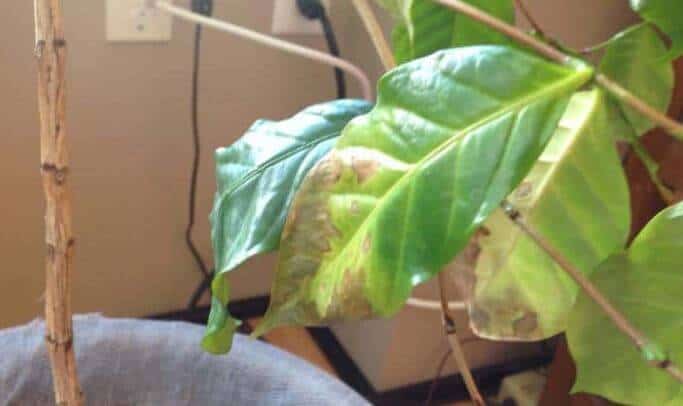Last Updated on May 19, 2023 by a Friendly Gardener
Members of the Rubiaceae family, Coffee plants boast beautiful fragrant star-shaped blooms in a delicate cream hue and red berries. Foliage is a glossy green and oval-shaped, and sometimes have serrated edges. Unfortunately, the beautiful foliage may occasionally become an unappealing brown color.
The Coffee Plant is resilient, so if you can identify the reason for foliage turning brown there’s a very good chance that your plant will make a rebound. With proper coffee plant care brown leaves will no longer be a problem.
Reasons for Coffee Plant Brown Leaves
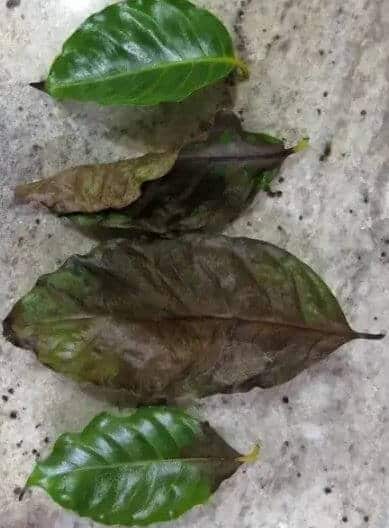
Coffee plants are sensitive to environmental conditions and can be fussy. There are several reasons that your Coffee Plant may be suffering and consequentially its leaves are turning brown. When your plant has an environmental issue, the foliage will begin to change color. They darken resembling a seaweed color. Leaf edges curl, darken, and droop. You may then notice coffee plant leaves turning brown and crispy. This may be due to overwatering, damaged root systems, or a fertilization issue.
To fix the situation it’s vital that you correctly determine what that cause is.
Improper Humidity Levels
The coffee plant originates in the tropics which offer high humidity levels. If the environmental air is too arid, and environmental humidity levels drop below 50%, foliage may simply be drying out to lack of adequate humidity. There are a variety of methods for increasing local humidity such as:
- Using a space humidifier
- Placing a tray of pebbles filled with water beneath your coffee plant’s container. Water should not touch the container base but sit below it.
- Misting your plant daily
- Grouping plants to create a microclimate through transpiration where houseplants emit moisture from their leaves into the surrounding air. Low humidity levels render transpiration difficult.
Improper Watering
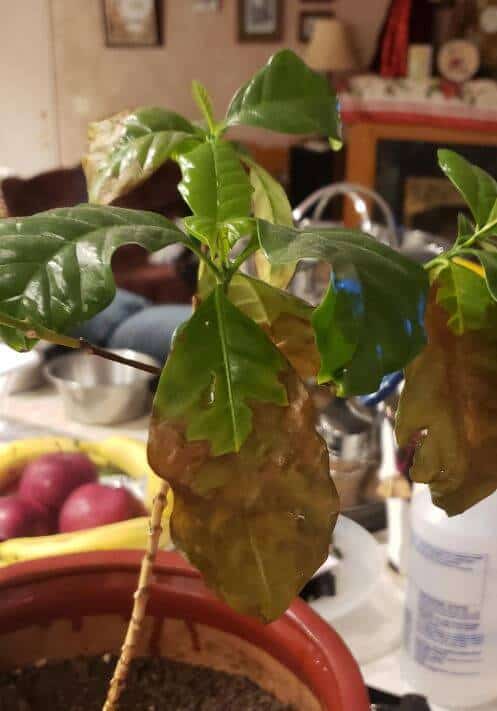
Underwatering your Coffee plant can discourage your plant’s transpiration. If your plant is thirsty, leaves may turn brown. Sufficient water is essential to the distribution of nutrients from the soil bed throughout your plant. Shrinking leaves also indicate a plant’s dehydration and need for a drink. Brown edges and leaf tips also indicate a watering issue.
Coffee plants are natives of tropical rainforests, so they are accustomed to generous watering. Municipal water that is heavy in minerals or chemical additives may likewise distress your plant, so consider using collected rainwater or distilled water and create a regular weekly watering schedule.
Excessive or Inadequate Sunlight
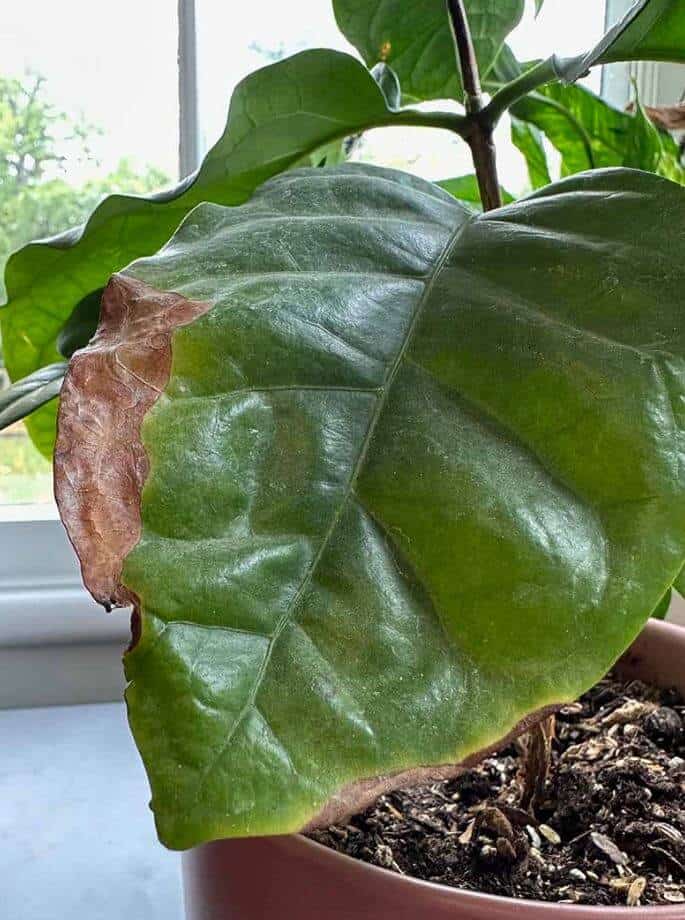
Coffee plants are considered understory plants in the tropics as they are not particularly tall. This means that in their natural habitats, they can be found under a canopy of other vegetation and trees. As a result, they enjoy dappled light rather than direct light. Direct sunlight exposure also brings heat, and your coffee plan is sensitive to environmental temperatures. Too much heat may impede proper functioning. Stunted growth and a lack of blooms may follow. Foliage will develop brown patches and decay.
If your plant has too little light exposure, it will be unable to produce sufficient energy and nourishment. Some leaves may begin to turn brown because the plant interrupts food to conserve energy.
Coffee plants love ample bright but indirect light. Excessive exposure to direct sunlight can burn and scorch leaves. If your plant is developing brown patches or brown leaves, it may be communicating that it needs a new location with bright indirect light.
Place your plant near a window or in partial shade to ensure adequate light while still protecting it.
Lack of Drainage

While a coffee plant prefers a moist soil bed, it will not thrive in soggy soil. Soil should be allowed to dry out somewhat between waterings. Failure to do so will result in overwatering. Soil that does not drain well, will eventually become waterlogged potentially leading to root rot. Browning foliage may indicate that your plant’s soil is too wet. At least a quarter of your Coffee plant’s soil should always be permitted to dry out before you water anew.
Should you suspect that your plant exhibit signs of root rot, you will need to examine the root ball. If roots are dark, slimy, and foul smelling, your plant has developed root rot, and you will need to act quickly to save it. Remove any damaged roots. Rinse the remaining root ball and treat it with a fungicide before planting it in a clean, sterilized pot with fresh soil.
Fungal Infections
Coffee plants are susceptible to fungal infections such as Coffee Leaf Rust. The fungus that most often attacks coffee plants is the Hemileia Vastatrix which will feed on your plant. Fungal infections are easier to identify as the foliage changes color gradually first developing a rusty color that will eventually turn brown as the fungus takes hold and spreads.
Another infection is Cercospora or Brown Eyespot Disease. Brown spots are circled by a yellowish halo. If you notice these spots, remove infected leaves.
Fungal infections can be treated with fungicides. These may be copper-based chemical sprays or natural horticultural oil such as neem oil. You can also prepare a fungicide in your kitchen by mixing baking soda (four teaspoons) into a gallon of water and spraying your plant. Fungal infections must be taken seriously and warrant rapid intervention. Fungal infections are highly contagious, so they can spread very quickly from one leaf to the next.
Ignoring Brown Leaves on Coffee Plants
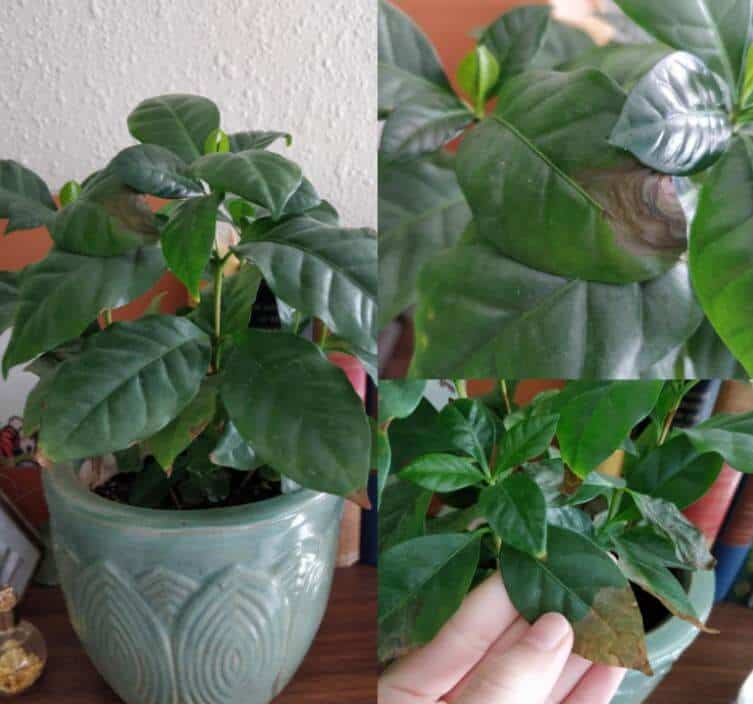
It is never a good idea to ignore coffee plant leaves browning. A delay in proper treatment can further damage your houseplant. Leaves are somewhat delicate, and a coffee plant can be temperamental. Delaying therapy will not benefit your plant.
If only leaf tips and edges turn brown, you can trim these parts off. If more than half of the leaf is brown, it is best to remove it.
Brown leaves left on the plant without any type of treatment will simply begin to decay. They will not heal or return green. The healthy green in foliage is a result of chlorophyll which aids in photosynthesis or how your plant nourishes itself. It assists the plant in absorbing sunlight.
Once leaves have turned brown, they no longer will absorb light and assume proper nourishment. They will deplete energy resources. Foliage will wilt and drop off. Stems and root systems will gradually weaken. Left untreated, your plant will die.
Should all the foliage on your plant turn brown, dispose of it.

